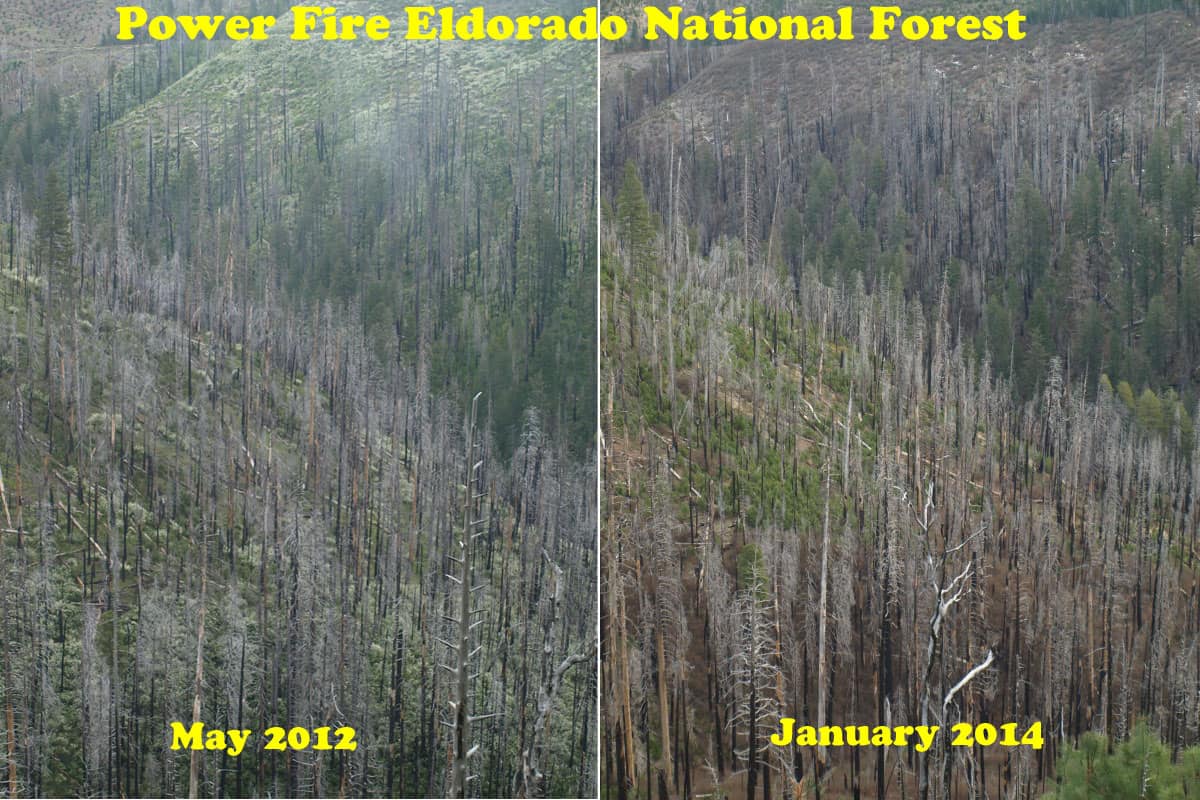It’s kind of a challenge to assemble pictures shot in different years, from different spots, and from different cameras. This is an excellent way to view and monitor trends, showing the public what happens over time to our National Forests. Sometimes, you have to look hard to see the differences. In any future repeat photography projects, I will be using very high resolution, to be able to zoom in really far.
One of the reasons why you don’t see much “recovery” is that the Eldorado National Forest has finally completed their EIS for using herbicides in selected spots, almost 10 years since the fire burned. This is part of the East Bay’s water supply. Sierra Pacific replanted their ground in less than 2 years. So, the blackbacked woodpeckers should be long gone, as their preferred habitat only lasts for an average of 6 years. As these snags fall over, the risk of intense soil damages from re-burn rises dramatically. Somewhere, I have some earlier pictures of this area which may, or may not line up well with this angle. I’ll keep searching through my files to find more views to practice with.

Larry, thanks for the before and after pictures. What is your plan?
1. Digital pictures? Subtract one picture from another to highlight the changes?
2. Photo interpretation by humans? Color enhanced?
Tom Craven of Dragon Plot may be interested if you are considering digital subtraction.
[email protected]
Yes, they are digital pics. The formal way to do it is to center the tripod over a monumented point, using the same zoom setting and hoping for similar lighting. Doing this during different times of the year means that time of day is relative. “Subtraction” would be impossible with these more random pictures (displayed here), as they aren’t exactly shot from the same spot. There is a sort of protocol to previous Repeat Photography work but, I assume that we might have to tweak it some, to deal with actual conditions.
If we get to do the Rim Fire, there will be plenty of concepts to illustrate, as well as just some more generic photos, as documentation. My buddy and I both worked on the Groveland Ranger District and have some places to revisit. We also hope to be able to explore the backcountry of Yosemite, via Aspen Valley, on a closed road. We intend to add comments and analysis about each picture, as well. I do think it is important to have good color fidelity but, I’m sure there will be a need to manipulate the exposure to deal with the expected contrast extremes of the Tuolumne River Canyon, and other north-facing slopes. We also want to cover as much of the burn as we can, with some “slop-over” as well, to capture bark beetle activity. It is also important to capture the areas where burn intensity was low, or even spotty. We should also request permission from SPI to show their land, as it becomes planted, applied with herbicides and re-populating their burned landscapes. “Objective sampling” must be the order of the day, and no condition within the Rim Fire should be ignored. The area around Hetch Hetchy, for example, has relatively scattered small burn patches, mostly associated with single digger pines burned. I expect that those kinds of impacts are and will continue to be benign.
Thanks for your interest, Richard.
I did find an early photo, taken before felling had started in this particular stand (2005) as shown in the above photos.
Notice how most of the trees have some green limbs and that this land went unmanaged before the fire burned. The project’s Harvest Inspector worked with the fallers as they worked below. He had to return at least five times, to pick up continued mortality, as the trees turned brown. I worked on the upper portion, and the mortality also proceeded at a frantic pace. You can also see the Sierra Pacific Industries’ ground, up there, in the back. Roadside hazards were cut, in the middle of this view. It certainly appears that the needs of the BBW were, indeed, properly addressed but, the Appeals Court didn’t agree. Hanson insisted, and the Court agreed, that EVERY tree (including hazard trees) that had ANY green needles on it must not be cut. Is this the “voice of reason” and scientific clarity?!?